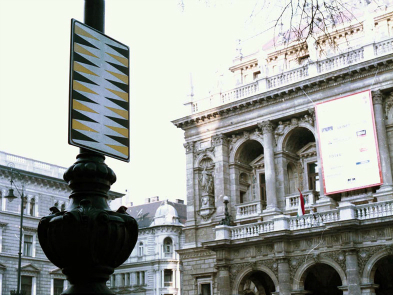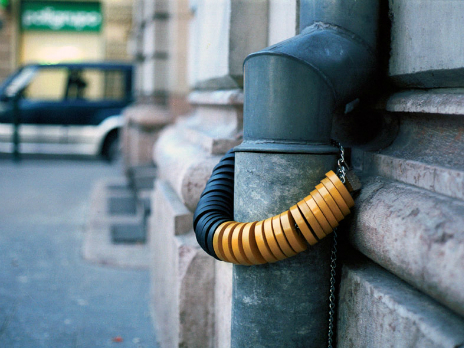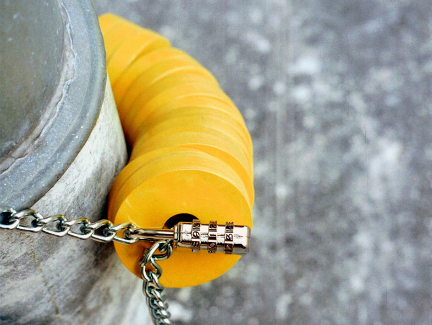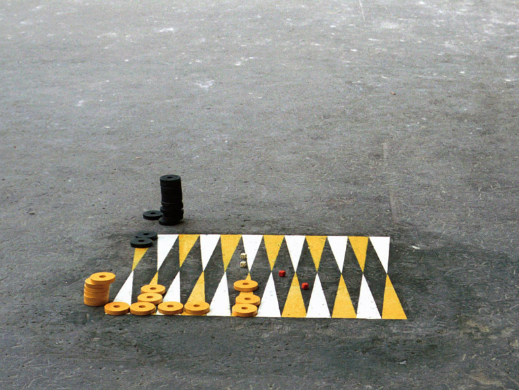Play Escape
PUBLIC ART OBJECT
We live together with objects which have been in our visual environment for some time now, however, it would be difficult to define their functions, purpose or significance. Here is one of them, made by Bori Benkő.
| Marsó Paula |
2014-06-30 11:40 |
In a certain respect Budapest is just inexhaustible: many of its remarkable characteristics are either hidden or slowly sinking into decay due to questionable renewal projects. Nevertheless, the lack of consistency this refurbishment rush has featured might be fruitful too. At least the survival of Bori Benkő’s public space work shows this.
 Let us imagine a notice board, an object, among all the other objects and boards of the street which, for some inexplicable reason, seems to resist time as well as the political chaos which often takes the disguise of urban planning. Backgammon has been standing where the artist planned it to stand since 2000. In the meantime it has gained respect and autonomy for itself without being a protected monument or work of art. How could this happen? Is it that when we do not understand something, but we feel we should, then we show more respect to these things? Do we tend to think that it has a hidden meaning which is clear for some others, but has not revealed itself to us. Or is it the visual appearance of the object with its arrows that demands us to pay a lot of respect to it? Or do we believe that deep beneath our technocratic world there is an archaic layer and this strangely obscure sign is its manifestation? Do those objects mean anything to me whose meanings I am not able to decipher? Still, what is this strange painted steel sheet at the level of traffic lights? A map? A verbose itinerary? A fire-fighter icon? A fresco from the sewerage operator?
Let us imagine a notice board, an object, among all the other objects and boards of the street which, for some inexplicable reason, seems to resist time as well as the political chaos which often takes the disguise of urban planning. Backgammon has been standing where the artist planned it to stand since 2000. In the meantime it has gained respect and autonomy for itself without being a protected monument or work of art. How could this happen? Is it that when we do not understand something, but we feel we should, then we show more respect to these things? Do we tend to think that it has a hidden meaning which is clear for some others, but has not revealed itself to us. Or is it the visual appearance of the object with its arrows that demands us to pay a lot of respect to it? Or do we believe that deep beneath our technocratic world there is an archaic layer and this strangely obscure sign is its manifestation? Do those objects mean anything to me whose meanings I am not able to decipher? Still, what is this strange painted steel sheet at the level of traffic lights? A map? A verbose itinerary? A fire-fighter icon? A fresco from the sewerage operator?
 |
 |
Only passionate board game players know the answer right away. They know that backgammon is a type of game which is played with a dice, 25 pieces of stones or checkers on a board consisting of 24 triangles. The history of backgammon goes back to ancient times and it is well-known in many cultures. The point of the game is to move our checkers onto our home board and then remove them all from there. The board paint pattern often appears in works of art: either as a form of geometric abstraction or as a part of a picture for example on Simon Quadrat’s painting (1946, London). Bori Benkő’s “board picture” refers, on the one hand, to the ritual function of art, and on the other, to the fact that art sometimes resists our efforts to understand it. We do not need to know what the intended meaning is, or if there is some intended meaning at all, if that particular work of art is meaningful for us. It is also true that art and games are very close to each other by nature. The board picture in question stands at an already non-existing place: the picture had an original function which has got lost by now. Namely the board signified the location of the game which was played on the patterns drawn on the pavement. The checkers were threaded together on a chain and the code for the lock spread by word of mouth. Quite similarly to the information exchange before the printing press.
 |
 |
For me, this work of art, independent of the game itself, means Budapest in the 2000s, where the borders of urban legends and reality are blurred, and where things are in constant formation, and by the time they find their shapes they have already lost their reason for existence. One of Budapest’s characteristics is exuberant waste: intellectual and creative energies find their ways to the surface and then they got wasted. Intellectual life is flourishing in Budapest, however the city is not a fertile ground in terms of evolving, saving and storing ideas. Bori Benkő (1977) has been living in Indonesia since 2005 studying Javanese and Balinese culture: with her experiments she produces paints from natural ingredients and paints on large canvasses in her seaside atelier.
 This work of art is located at a lamp post in Andrássy street opposite the Opera House, in front of the former Ballett Academy.
This work of art is located at a lamp post in Andrássy street opposite the Opera House, in front of the former Ballett Academy.
For more info on Bori Benkő click here.
Photo: Bori Benkő